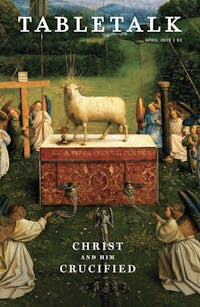
Request your free, three-month trial to Tabletalk magazine. You’ll receive the print issue monthly and gain immediate digital access to decades of archives. This trial is risk-free. No credit card required.
Try Tabletalk NowAlready receive Tabletalk magazine every month?
Verify your email address to gain unlimited access.
A pair of lines from Augustus Toplady’s eighteenth-century hymn “Rock of Ages” address what Christ’s atonement brings about in the Christian’s life: “Be of sin the double cure, Save me from its guilt and power.” A look at the life and teaching of another rock, the Apostle Peter (Petros means “rock”), will provide insight into the meaning of these poignant lines.
Peter the Man
The picture we have of Peter in the Gospels is of a disciple who had trouble getting out of his own way. He was at turns brashly presumptuous (Matt. 16:22; 17:3–4; Mark 14:29) and zealous for the Lord’s honor (Luke 22:49–50). At his worst, he was a denier of Christ (John 18:15–18, 25–27).
Between the Gospels and his epistles, there is a change. After Peter was restored in John 21:15–19, he burst on the scene of the early church giving bold witness to Christ. What is more, in his letters, he is no longer the fumbling Apostle—he’s a mature believer calling other believers to maturity.
What power worked in his life effecting such a change? Of course, we can point to the Holy Spirit sowing seeds that produce increasingly visible fruit in Peter’s personality. But there is an objective touchstone to which we can point, to which Peter himself pointed: the blood of Christ.
Peter’s Message
As Peter opens his first letter, he addresses a diverse group of Christians dispersed throughout Asia Minor (modern-day Turkey) and celebrates the triune God’s work in their lives: the Father foreknew them, the Spirit sanctifies them, and Jesus Christ sprinkled them with His blood (1:2).
The language of sprinkling recalls Old Testament images that tied blood to the forgiveness of sin. Three of these passages will help us understand Peter’s message about the blood of Christ’s crucifixion.
Leviticus 4 is shot through with the concern of human sin and guilt before God. It is equally shot through, though, with the grace of God in providing the removal of guilt through the sin offering. The priest would slaughter a bull and sprinkle its blood seven times before the Lord (vv. 6, 17). The result is atonement and forgiveness for sin.
Exodus 12 takes place in the midst of the plagues on Egypt for Pharaoh’s refusal to let God’s people go. The final plague is the killing of the firstborn throughout the land. The only way to avoid this horror is for God’s people to slaughter a spotless lamb and put its blood on their doorposts (vv. 3–13). The result: God in His judgment would “pass over” a house marked by blood—the lamb dying and receiving the judgment instead of those inside.
Exodus 24 provides a vivid picture of bloody atonement. Moses confirms the covenant between the Lord and His chosen people, at which time the people promise to obey the word of the covenant, and in response they and the altar are sprinkled with the blood of the covenant (v. 8). This symbolizes that, despite the people’s promise to obey, there is a provision for disobedience—a covering in atonement.
Each of these three passages is fulfilled in Christ. He is our once-and-for-all sin offering who eternally removes the guilt that our sin brings before God (Heb. 9:11–12). He is our substitute (1 Peter 3:18), the spotless Lamb by whose blood our guilt is removed so that God passes over us in judgment (1 Peter 1:19). And His blood is the provision for our ongoing battle in imperfectly killing sin and pursuing obedience to Jesus Christ. Interestingly, 1 Peter 1:2 refers to “obedience to Jesus Christ” in addition to “sprinkling.”

When Peter speaks, then, of the “sprinkling of blood,” he is telling Christians that their record of guilt has been covered in the blood. God no longer sees it, and so in His judgment He passes over it. By the bloody wounds of Christ we have been “healed” (1 Peter 2:24). This is the first “cure” of which Toplady would have us sing.
The implications of Exodus 24, however, begin to point forward to the second “cure” of Christ’s atonement: through the blood we recognize ongoing provision for sin in the Christian life so that our transgressions are not held against us. Indeed, with consciences washed of guilt through the blood (Heb. 9:14), we are granted powerful freedom to pursue obedience.
Peter points in this direction when he writes, “He himself bore our sins in his body on the tree, that we might die to sin and live to righteousness” (1 Peter 2:24). Because of the atoning blood of the cross, we pursue righteousness. But we do not do so unrealistically, as if we do not need the continual forgiveness for the sins that will mark our lives until Christ returns. We do not do so fearfully, as if our efforts are built on our own crumbling foundation. Rather, we do so hopefully, knowing we can resist sin through efforts built on the firm foundation of atoning blood and empowered by the Holy Spirit. Just as the blood of Exodus 24 constituted God’s people so that they could commence their obedient pilgrimage to the promised land, so Christ’s blood of the new covenant constitutes us as a forgiven people who walk toward God in obedient holiness.
Peter knew the crucifixion cleared his guilt (1 Peter 5:1). He knew that through the power of the blood he could “resist” the devil and pursue obedience (v. 9). Sprinkled with the blood, Peter increasingly died to sin and lived to righteousness. The result: the once brash and immature disciple became a repentant and mature disciple—saved from the guilt and increasingly from the power of sin.
